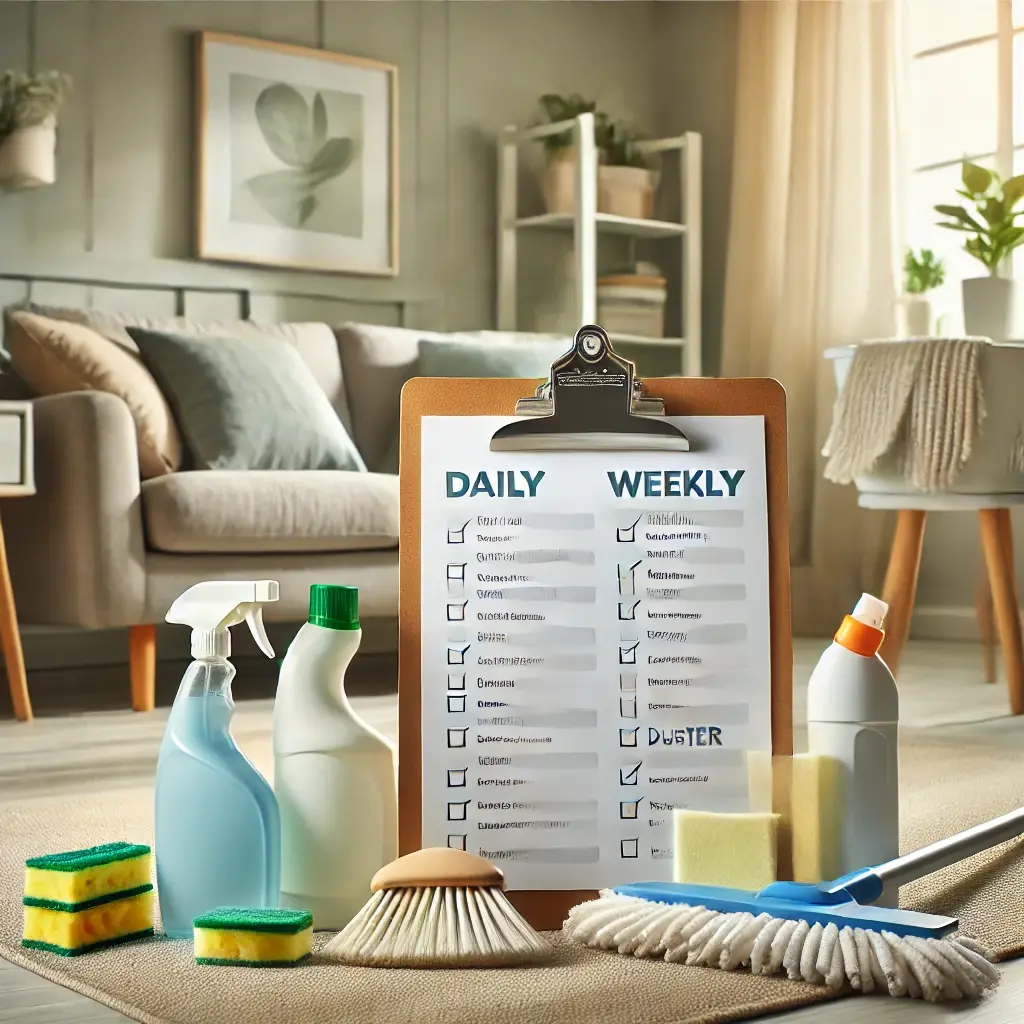Keeping your home clean and organized can feel overwhelming, especially if you don’t have a structured plan in place. That’s where a personalized cleaning schedule comes in. A cleaning schedule helps you stay on top of chores without feeling burdened, breaking tasks into manageable routines that fit your lifestyle. Whether you have a busy family life or live solo, this guide will walk you through creating a cleaning schedule that works for you so your home stays neat and stress-free.
Assess Your Needs and Priorities
Before creating a schedule, it’s important to assess what needs cleaning and how often. This will help you prioritize tasks based on the areas of your home that get the most use.
Identify Problem Areas
Walk through each room of your home and make a list of tasks that need to be done. Focus on areas that accumulate the most dirt, clutter, or wear and tear. Common problem areas might include:
- Living Room: Dusting, vacuuming, and organizing.
- Kitchen: Cleaning countertops, appliances, and the sink.
- Bathroom: Scrubbing the toilet, shower, and sink, plus wiping down mirrors.
- Bedrooms: Changing bedding, vacuuming, and decluttering.
- Entryway or Mudroom: Sweeping, mopping, and organizing shoes.
- Tip: Be realistic about what needs attention daily, weekly, and monthly. Not every task needs to be done every day!
Assess Your Lifestyle
Think about your weekly routine and how much time you realistically have for cleaning. If you’re working full-time or caring for a family, you may need to spread out tasks. Alternatively, if you have more free time, you can dedicate longer cleaning sessions.
- Tip: Don’t over-schedule yourself. It’s better to have a simple routine you can maintain than to aim for perfection and get overwhelmed.
Break Down Tasks by Frequency
Once you’ve identified the tasks that need to be done, the next step is to decide how often to do them. Breaking tasks into daily, weekly, and monthly categories will help you organize them effectively.
Create a List of Daily Tasks
Daily cleaning tasks are small chores that keep your home looking tidy every day. They don’t require much time, but doing them regularly helps prevent messes from piling up.
- Examples of daily tasks:
- Make the bed.
- Wipe down the kitchen counters and the dining table.
- Wash dishes or load/unload the dishwasher.
- Declutter common areas (like putting away toys, magazines, or mail).
- Take out the trash if full.
- Tip: Try to complete daily tasks as part of your morning or evening routine. This makes them feel like less of a chore and keeps your home in a constant state of cleanliness.
Plan Weekly Tasks
Weekly tasks are more involve chores that don’t need to be done every day but are essential to maintaining a clean home.
- Examples of weekly tasks:
- Vacuum or sweep floors.
- Mop hard floors.
- Clean bathrooms (toilet, sink, shower).
- Dust surfaces and light fixtures.
- Change bedding.
- Tip: Assign specific tasks to certain days of the week. For example, vacuum on Tuesdays and clean the bathroom on Fridays. This makes it easier to remember and ensures you’re not doing everything at once.
Schedule Monthly and Deep-Cleaning Tasks
Monthly tasks involve deep cleaning and maintaining areas that aren’t in daily use or don’t get dirty as quickly. These tasks help you stay ahead of bigger messes that can develop over time.
- Examples of monthly tasks:
- Clean windows.
- Wash curtains or vacuum blinds.
- Deep-clean appliances (oven, microwave, refrigerator).
- Organize closets and drawers.
- Clean baseboards and dust ceiling fans.
- Tip: Choose one or two monthly tasks to complete each week to spread them out. This way, you won’t feel overwhelmed trying to deep-clean everything at once.
Customize Your Schedule

Now that you’ve categorized tasks by frequency, it’s time to create a personalized schedule. This will vary depending on how much time you can dedicate to cleaning and how you prefer to break up your chores.
Choose Your Cleaning Style
There are different approaches to creating a cleaning schedule. Choose one that fits your lifestyle:
- Daily cleaning blocks: Spend 15-30 minutes a day doing small cleaning tasks. This keeps your home tidy on a regular basis and avoids long cleaning sessions.
- Weekly cleaning sessions: Dedicate one or two days a week to deep cleaning the entire house. This is great for people who prefer to get all their chores done in one go.
- Room-by-room: Focus on cleaning one room each day. For example, clean the kitchen on Monday, the bathroom on Tuesday, etc. This approach spreads tasks out evenly across the week.
- Tip: If your schedule is unpredictable, go for smaller daily tasks. If you have free weekends, a longer weekly session may work better.
Use a Template or App
To stay organized, you can use a printed cleaning schedule template or a cleaning app to track your tasks. Templates allow you to plan your cleaning for each day, while apps can remind you of tasks based on the schedule you set.
- Recommended Apps:
- Tody – Lets you organize chores and see what needs attention based on priority.
- Clean My House – Helps you assign tasks to specific days and track your progress.
- Tip: If you prefer a physical list, a chalkboard or whiteboard in a common area like the kitchen can help keep you on track.
Make Your Schedule Flexible and Sustainable
The key to a successful cleaning schedule is making it flexible and manageable. A rigid plan can lead to burnout, so be prepared to adjust it as needed.
Build in Catch-Up Days
Life gets busy, and there will be days when you don’t get to every task on your list. That’s okay! Make sure to schedule a catch-up day at the end of the week where you can tackle any missed chores.
- Tip: Sundays are a great catch-up day before the start of a new week. Use this time to complete unfinished tasks or simply rest and reset.
Get the Family Involved
If you live with family or roommates, don’t hesitate to share the load. Assign age-appropriate tasks to kids and split larger cleaning jobs among adults.
- Tip: Create a chore chart that assigns daily or weekly tasks to each family member. This helps everyone contribute to keeping the home clean.
Don’t Aim for Perfection
Remember that a cleaning schedule is about maintaining a tidy, livable home, not perfection. It’s okay to have days when you don’t get everything done. The goal is to create a sustainable routine that works for you, not to achieve a spotless home every day.
Example Cleaning Schedule
Here’s a simple example of how to structure your cleaning tasks throughout the week:
| Day | Daily Tasks | Weekly Task |
| Monday | Make bed, wipe counters | Vacuum living room and bedrooms |
| Tuesday | Load/unload dishwasher, tidy up | Clean kitchen (counters, sink, stovetop) |
| Wednesday | Take out trash, wipe surfaces | Clean bathrooms (toilet, shower, sink) |
| Thursday | Make bed, tidy living area | Dust furniture and light fixtures |
| Friday | Load/unload the dishwasher, tidy up | Mop hard floors |
| Saturday | Declutter common areas | Change bedding, do laundry |
| Sunday | Catch-up day | Deep-clean fridge or appliances |
Conclusion
A cleaning schedule is a great way to stay organized, reduce stress, and keep your home looking its best. By assessing your needs, breaking tasks into manageable routines, and customizing your schedule to fit your lifestyle, you can create a cleaning plan that works for you. Remember to be flexible, get the family involved, and celebrate your progress as you build a sustainable routine.
FAQs
You should vacuum high-traffic areas like the living room and entryway once or twice a week. Low-traffic areas, like bedrooms, can be vacuumed once a week.
Set small, achievable goals and tackle one task at a time. Stick to a routine, but be flexible when life gets in the way. Use apps or a visual checklist to stay on track.
Absolutely! Your schedule should evolve based on your needs, routine changes, or unexpected events. Feel free to rearrange tasks or add extra days for deep cleaning when necessary.
Break down tasks into manageable chunks of time (15-30 minutes). Focus on one area per day or split tasks into daily and weekly categories, so you’re not doing everything at once.
Don’t stress! Simply move the task to your next cleaning session or catch-up day. The goal is consistency, not perfection.





